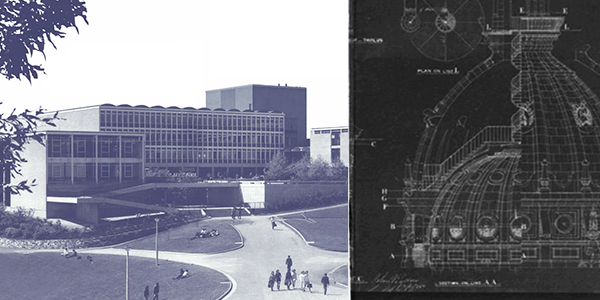'Campus' and 'An Unfinished Masterpiece'

The Australian Centre for Architectural History, Urban and Cultural Heritage (ACAHUCH) is pleased to announce the launch of two new publications.
'An Unfinished Masterpiece', written by Gideon Haign, features a pictorial essay by long-time ACAHUCH collaborator Peter Elliott, Founding Director of Peter Elliott Architecture + Urban Design.
'Campus: Building Modern Australian Universities', edited by A/Prof Andrew Saniga and Prof Robert Freestone, also features contributions by ACAHUCH Co-Directors Prof Philip Goad and Prof Hannah Lewi, alongside collaborators of ACAHUCH including Susan Holden, A/Prof Cameron Logan and A/Prof Christine Garnaut. This publication was supported by an Australian Research Council Discovery Project Grant and features chapter authors Robert Freestone, Philip Goad (ACAHUCH), Christine Garnaut, Hannah Lewi (ACAHUCH), Andrew Murray (ACAHUCH), Nicola Pullan and Andrew Saniga (ACAHUCH).
To celebrate, we will be launching in the Japanese Room on Tuesday 29th August at 5:15pm.
Please register for catering purposes using the link on the left.
---
CAMPUS: BUILDING MODERN AUSTRALIAN UNIVERSITIES | A/Prof. Andrew Saniga (University of Melbourne) and Prof. Robert Freestone (UNSW) (eds.)

University campuses are now a fixture of practically every major city in Australia but often go under-appreciated as built environments. This collaborative history sheds light on the origins and evolution of campus design from the Second World War to the current day. It explores built legacies and design strategies set against the backdrop of the development of higher education in Australia’s continuing cultural evolution.
Times change but what remains is the importance of the design, landscape and buildings of university campuses in shaping and supporting the quality of life and work of the university community. Campuses profoundly shape the immediate experiences, as well as the memories of significant times, in the lives of those who pass through them. They are substantial new manifestations of urban civic life.
The essays on modern Australian universities presented in Campus are deep and wide, setting their features in the socio-economic, political and urban context in which they have developed. This is a particularly rich collection from which to reflect on the particularities and commonalities of the Australian university campus.

Andrew Saniga is an Associate Professor of Landscape Architecture, Planning and Urbanism at the University of Melbourne. His research includes the history of landscape architecture in Australia and his writings have documented and explained key designers and projects with an emphasis on the mid-twentieth century. His book Making Landscape Architecture in Australia (2012) won the Victoria Medal from the Australian Institute of Landscape Architects. He teaches design and history of landscape architecture and is a registered landscape architect with the Australian Institute of Landscape Architects and a member of DOCOMOMO International.
Robert Freestone is Professor of Planning in the School of Built Environment at UNSW Sydney. His research includes urban planning history, metropolitan planning and public policy. His authored and edited books include Iconic Planned Communities and the Challenges of Change (2019), Designing the Global City (2019), Planning Metropolitan Australia (2018), Urban Nation: Australia’s Planning Heritage (2010), and Urban Planning in a Changing World (2000). He is a Fellow of the Australian Academy of Humanities, Academy of Social Sciences in Australia, Institute of Australian Geographers, and the Planning Institute of Australia.
AN UNIFINISHED MASTERPIECE | Gideon Haigh (Journalist) & Peter Elliott (Peter Elliott Architecture + Urban Design)

Victoria's Parliament House is widely regarded as one of Australia's most significant public buildings. Planning for it began in the early 1850s and today, some 170 years later, the building remains a grand but unfinished masterpiece. Peter Kerr is the architect whose inspired design has come to represent the aspirations and visions of our founding democracy. Kerr toiled on and off over a 40-year period with a gentle tenacity, weathering numerous setbacks and political crises. He is an inspiration to every architect. He could draw beautifully, producing hundreds of exquisite drawings in very quick time, and was clearly a man of many talents who brought a sophisticated design sensibility, innovative thinking and capacity for meticulous detailing to every aspect of the building. His great achievement though is the manner of the architecture, conceived at the very foundation of the city. This monumental structure, intended to evoke the splendour of imperial Rome, embodies the highest ideals of 19th-century civic architecture. As the architectural historian George Tibbits observed, the great spaces in this building are more than a delight to the eye; they afford a deep satisfaction to the intellect and spirit.

Gideon Haigh has a journalism career spanning over 40 years. Initially writing as a business and feature writer for 11 years, he went solo in 1995 and has been writing across over 100 publications and mastheads since. Most commonly known for his commentary and journalism on sport - particularly cricket - Haigh has also authored 50 books and been awarded numerous times for these.
Peter Elliott is a Melbourne architect and recipient of the 2017 Gold Medal from the Australian Institute of Architects. He is an Adjunct Professor of Practice at the Faculty of Art Design & Architecture at Monash University. He has a special interest in the design of the public realm, and has lectured and written extensively on contemporary architecture and urban design. In 2015 he authored a monograph book titled “Episodic Urbanism – RMIT Urban Spaces Project 1996 – 2015’